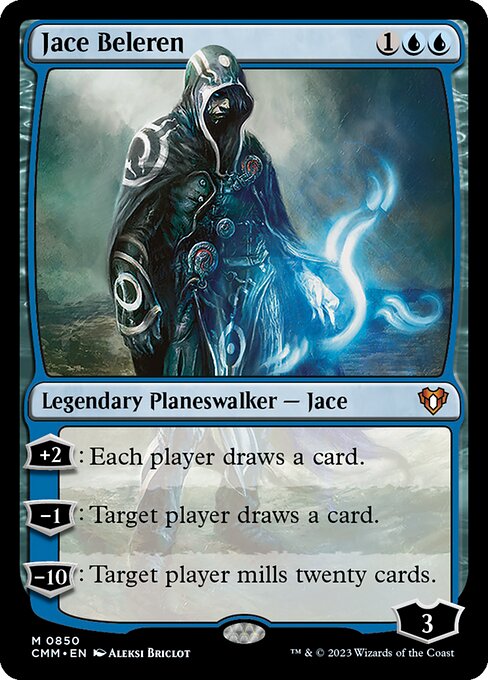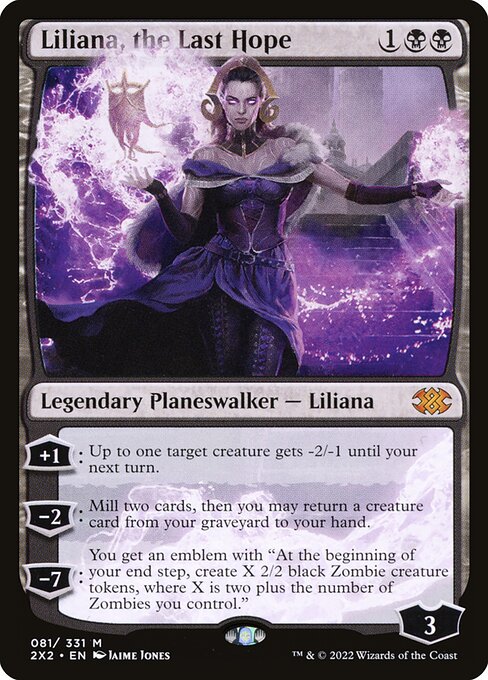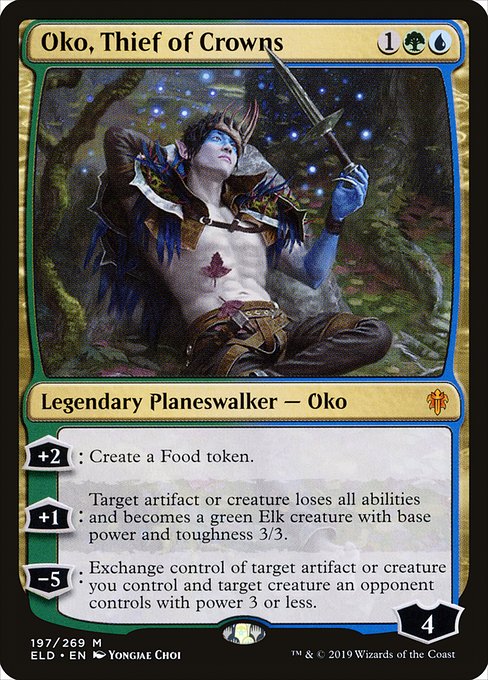Thirty-two three-mana planeswalkers have been printed in Standard-legal sets since 2006. This does not count the three flip walkers printed in Origins, as they’re not generally planeswalkers on turn three. Of those, 25 have been printed since Kaladesh block in 2016. Even if you cut out War of the Spark entirely, eleven three-mana planeswalker have been printed in the last three years, more than the number printed from 2006-2016. With that kind of trend, is it any wonder we eventually got an Oko?
The very first three-mana planeswalker was among the first to see print. Jace Beleren lacked any meaningful way to protect himself or interact with the battlefield. The only protection he offered was the political shield of symmetrical card draw and a relatively hefty five loyalty. He saw sideboard play in Faeries and in some extremely fun Howling Mine-enabled decks upon his reprint in M10, but the symmetry of his design and peak state as a pain-free Phyrexian Arena kept him restrained to role-player status.

The next three-mana planeswalker wasn’t printed until Innisrtrad. Liliana of the Veil is the epitome of “overpowered, but allowable.” She’s great, but she’s pillar-of-the-format great, not metagame-warping great. She saw a fair amount of play in Standard once Return to Ravnica brought shocklands and Jund back; but there wasn’t much to break the symmetry of her +1—notably, Pro Tour Dark Ascension featured a grand total of one copy in Mamoru Nagai’s sideboard. Once she rotated out, though, she became a format staple in Modern for a decade. Again, the +1 appears to be symmetrical card parity. But as anyone who’s played her can tell you: she isn’t Jace Beleren, but a brutal tax on your opponent’s resources.
Sporadic three-mana planeswalkers appeared since then, with Ajani, Caller of the Pride seeing no play and Ashiok, Nightmare Weaver seeing some situational play. Nissa, Voice of Zendikar saw frequent play as a flexible Glorious Anthem slash low-power Bitterblossom who demanded an immediate answer. Then, in 2016, came Liliana, the Last Hope. She ended up like her predecessor—extremely powerful, playable in Standard, but better in formats with more options; I have high hopes for her in Pioneer.

The second three-mana iteration of Liliana was followed by Saheeli Rai, unplayable outside of an infinite combo, and Jace, Cunning Castaway, who is outright unplayable. In between came the most dangerous three-mana planeswalker yet: Gideon of the Trials. Rather than a card advantage engine, Gideon was a sticky threat combined with pseudo-removal. He didn’t break any formats or dominate any decklists, but he was a powerful and popular card—and the face of Amonkhet. Jace, Cunning Castaway, likewise the marquee card for his respective set, was a misfire; but Gideon of the Trials was pushed a bit more to bolster the appeal of Amonkhet. He saw no Pro Tour play, and only sporadic play in competitive lists since, but it was a hit of what was to come in terms of “face cards” for individual sets.
Pre-Oko, it seemed like Wizards was getting the pattern down for three-mana planeswalkers—the tribal focus of Sarkhan, Fireblood and Sorin, Imperious Bloodlord meant that they could be situationally powerful without being auto-includes in decks in their colors. Planeswalkers like Ajani, Caller of the Pride, Saheeli Rai, and Ashiok, Nightmare Weaver lacked ways to defend themselves, and could be dealt with early on through combat damage. Even the most powerful three-mana planeswalkers—Liliana, the Last Hope, Nissa, Voice of Zendikar, and, to a lesser extent, Domri Rade—were carefully balanced with the “+ loyalty for minor protection, – loyalty for card advantage, expensive ultimate” pattern. Coupled with Wizards’ decision to print cards that directly interacted with planeswalkers—verboten until Return to Ravnica’s Dreadbore—this meant an environment where cheap interaction could balance cheap planeswalkers.
And then came 2019.
Ravnica Allegiance brought us Kaya and Dovin, both of which follow the Sarkhan/Sorin model of highly situational abilities that don’t offer outright card advantage. Dovin is weak and Kaya saw some Modern buzz, but her ceiling is low. Nothing problematic there, but those conservative planeswalkers presaged a huge development: War of the Spark and its “a olaneswalker in every pack” abundance.

Obviously, War of the Spark was an outlier, and many of its fourteen three-mana ‘walkers were designed for Limited, but it still gave us the fourth best three-mana walker in history in Teferi, Time Raveler, role-players in Ashiok, Domri, and Vivien, and a Vintage-warping Narset. The aftershocks of War of the Spark will be felt for years, but even the miseries of Teferi mirrors couldn’t prepare us for what came later that year in Oko, Thief of Crowns.
So what went wrong? For years, Wizards treated the three-drop slot as a dangerous zone for planeswalkers. Dropping a source of recurring card advantage on turn three (or turn two in formats with a Birds or Elves) can swing the game in ways that alienate the player base and make metagames stagnant. Since 2015, Wizards seems to have gotten confident in their ability to design cheap planeswalker and to balance them out with flexible removal until Oko. The issue is twofold: one, that Oko’s loyalty is too high and the numbers off on his abilities and two, that the same cards designed to handle Oko were targets for transmutation. All the Questing Beasts can’t save you when they’re turned into 3/3 Elks.

Put simply, Oko was a mistake. Much like Skullclamp or Umezawa’s Jitte, the concept was strong, but the numbers were off. Change the Beast Within ability to a -1 or a -2, and the conversation around the puckish walker would have been very different.
It’s a small target to hit: making planeswalkers powerful enough to drive booster sales and increase player investment without destroying metagames and driving out players. Scan the deck lists of the most recent Mythic Championship and see what it looks like when Wizards drops the ball on designing appropriate three-mana planeswalkers. Oko is a small mistake that warped formats, affected Standard participation, and hamstrung the development of formats at a sensitive time—as Wizards embarks on a slow pivot to digital games, redoubles their player acquisition efforts, and lauds their Play Design team for their work at balancing tournament-playable cards.
In the fallout of Oko, I keep coming back to the flavor text of his best friend and enabler, Hydroid Krasis: “Havoc is a small price to pay for data.” We now know the ceiling for a three-mana planeswalker, but at what cost?
A lifelong resident of the Carolinas and a graduate of the University of North Carolina, Rob has played Magic since he picked a Darkling Stalker up off the soccer field at summer camp. He works for nonprofits as an educational strategies developer and, in his off-hours, enjoys writing fiction, playing games, and exploring new beers.

